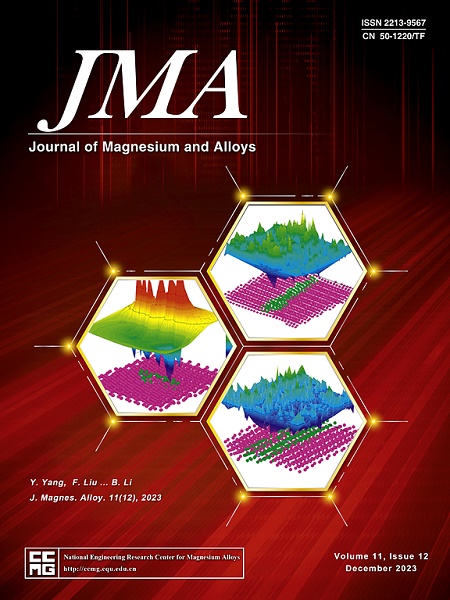Effect of cooling rate on corrosion resistance and behavior of micro-alloyed cast AZ91-Ca-Y alloy
IF 13.8
1区 材料科学
Q1 METALLURGY & METALLURGICAL ENGINEERING
引用次数: 0
Abstract
Micro-alloying is an effective approach for improving the corrosion resistance of cast AZ91. However, the effect of micro-alloyed elements on corrosion resistance can be varied depending on the solidification rate influencing the diffusion and precipitation behavior of micro-alloying elements. This study investigated the effects of the cooling rate on the microstructure and corrosion behavior of micro-Ca and -Y alloyed cast AZ91 alloy (i.e., AZXW9100). To achieve various cooling rates, the alloys were prepared using three methods: steel mold casting (SMC), copper step mold casting (CSMC), and high-pressure die casting (HPDC). The corrosion behavior was analyzed through weight loss measurements, electrochemical impedance spectroscopy, and corrosion morphology observations. The results showed that the key microstructural factors influencing corrosion resistance differed between short- and long-term corrosion. As the cooling rate increased, the short-term corrosion rate was lowered from 0.91 mm/y (SMC) to 0.38 mm/y (HPDC), which was attributed to the decrease in the total area fractions of the eutectic α and β phases acting as galvanic corrosion sources. The long-term corrosion rate was reduced from 17.20 mm/y (SMC) to 0.71 mm/y (HPDC), which was revealed to be due to the enhanced connectivity of the β phase acting as corrosion barriers. Meanwhile, the increase in the cooling rate led to a modification of the Zn molar ratio in the β phase, reducing the Volta potential of the β phase from 101.8 mV to 66.9 mV. This reduction in the Volta potential of the main galvanic source also contributed to improved corrosion resistance. The HPDC AZXW9100 alloy produced in this study exhibited the lowest corrosion rate compared to other alloys. These findings suggest that controlling the cooling rate is a promising strategy for enhancing the corrosion resistance of AZXW9100 alloys.


冷却速率对微合金化铸造AZ91-Ca-Y合金耐蚀性能的影响
微合金化是提高铸态AZ91耐蚀性的有效途径。然而,微合金元素对耐蚀性的影响取决于凝固速率,而凝固速率会影响微合金元素的扩散和析出行为。研究了冷却速率对微ca -Y合金铸造AZ91合金(即AZXW9100)显微组织和腐蚀行为的影响。为了实现不同的冷却速率,采用三种方法制备合金:钢模铸造(SMC)、铜阶模铸造(CSMC)和高压压铸(HPDC)。通过失重测量、电化学阻抗谱和腐蚀形貌观察来分析腐蚀行为。结果表明,影响耐蚀性的关键组织因素在短期腐蚀和长期腐蚀中存在差异。随着冷却速率的增加,短期腐蚀速率从0.91 mm/y (SMC)降低到0.38 mm/y (HPDC),这是由于作为电蚀源的共晶α和β相的总面积分数减少所致。长期腐蚀速率从17.20 mm/y (SMC)降低到0.71 mm/y (HPDC),这是由于β相作为腐蚀屏障的连通性增强所致。同时,随着冷却速率的增加,β相中Zn的摩尔比发生了变化,β相的Volta电位从101.8 mV降低到66.9 mV。主电源伏特电位的降低也有助于提高耐腐蚀性。与其他合金相比,制备的HPDC AZXW9100合金的腐蚀速率最低。研究结果表明,控制冷却速度是提高AZXW9100合金耐腐蚀性能的有效方法。
本文章由计算机程序翻译,如有差异,请以英文原文为准。
求助全文
约1分钟内获得全文
求助全文
来源期刊

Journal of Magnesium and Alloys
Engineering-Mechanics of Materials
CiteScore
20.20
自引率
14.80%
发文量
52
审稿时长
59 days
期刊介绍:
The Journal of Magnesium and Alloys serves as a global platform for both theoretical and experimental studies in magnesium science and engineering. It welcomes submissions investigating various scientific and engineering factors impacting the metallurgy, processing, microstructure, properties, and applications of magnesium and alloys. The journal covers all aspects of magnesium and alloy research, including raw materials, alloy casting, extrusion and deformation, corrosion and surface treatment, joining and machining, simulation and modeling, microstructure evolution and mechanical properties, new alloy development, magnesium-based composites, bio-materials and energy materials, applications, and recycling.
 求助内容:
求助内容: 应助结果提醒方式:
应助结果提醒方式:


